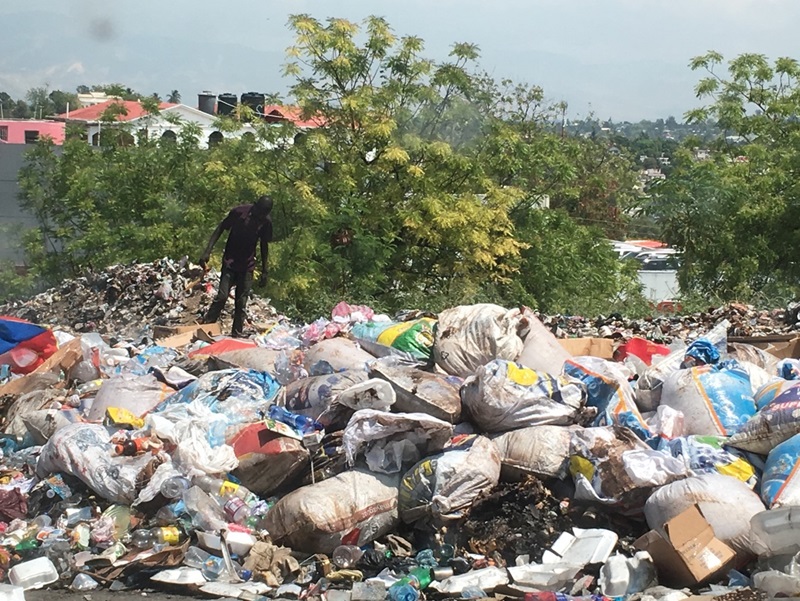
Resilience or Immunity: Social Class and The Paradox of COVID-19 in Haiti
Jean Max Charles, PhD, IIE Centennial Fellow; Lecturer, Department of Sociology, University of Miami
Due to the extreme vulnerabilities of the public health system in Haiti, the crowded living conditions of the population, and the weakness of the Haitian state, it was expected that COVID-19 would ravage the country. Epidemiologists and public health care officials feared that the system would be overwhelmed with COVID-19 patients. One model predicted up to 20,000 deaths.[1] Shortly after the first case was diagnosed on March 19, 2020, NGOs began to mobilize resources to help the country. The government opened several health centers to care for the people infected by the virus.
Defying all odds and surprising the world, it has turned out that the impact of the COVID-19 in Haiti has been considerably low as the country experienced relatively few deaths. The title of an article published by Jason Beaubien, an NPR’s Global Health and Development correspondent is very telling: “One of The World’s Poorest Countries Has One Of The World’s Lowest COVID Death Rates.”[2] As a result of the low COVID-19 infection and death rates, in August 2020, the government closed all the COVID-19 treatment centers. NGOs redirected funds to other countries where the impact was much more severe. During the first wave and until December 2020, Haiti reported only 234 confirmed cases. From the beginning of the pandemic through August 2021, the country counted 20,556 cases and 576 deaths.[3] Cases could be underreported due to a lack of testing but the reality is COVID-19 treatment centers were closed due to a lack of patients.
Contrarily, the Dominican Republic, which shares the island with Haiti, has been more impacted by the pandemic. As of August 5, 2021, the U.S. Embassy in the Dominican Republic’s website[4] reports the number of confirmed cases in the Dominican Republic as 343,512 and confirmed deaths to 3,973. The surprising low impact of COVID-19 in Haiti retains the attention of many and requires some explanations.
Resilience or Immunity?
Based on these statistics, some believe that Haiti has developed a rare resilience to COVID-19.[5] I view resilience as the social, economic, and environmental factors that allow a community to withstand natural events and to quickly recover when they occur. Such factors include appropriate municipal infrastructure; protection of the environment; a robust public health care system; gender integration; increased financial capacities; promotion of education and disaster awareness; and policies to reduce risk, prepare for, and respond to disasters. Based on this definition, one can refute the argument that Haiti has developed a resilience against COVID-19. Indeed, the health care system is extremely weak and vulnerable, the government is inefficient, the Haitian population remains defiant to the mitigation strategies against COVID-19. The majority of the population does not wear masks, observe social distance, or avoid crowded spaces. If Haitian people have developed a rare immunity against COVID-19, it is not because anything was done externally, but instead that their bodies developed a resistance to the COVID-19 virus, which resistance resembles a form of immunity.
Immunity, as it relates to health, signals a body’s natural defense to a particular infection. It involves the actions of specific antibodies that form a barrier against a wide range of pathogens. In the case of Haiti, which could be also the case in many underdeveloped countries, I hypothesize that the population developed immunity against the COVID-19 virus. The development of this form of immunity has been made possible through the population’s long-term exposure to unsanitary conditions, microbes, and bacteria. The majority of the Haitian population, particularly in the large cities of the country, live in extreme conditions of insalubrity, drink polluted water, and neglect basic hygiene principles.

Picture of a man looking for recycling goods in a pile of trash in Port-au-Prince, taken by Jean Max Charles, March 2019.
This fact is not surprising to any Haitian. The conditions of insalubrity in Haiti have dramatically deteriorated during the past two decades. When I returned to Haiti in 2018, after 15 years of living in the US, I was astonished to see the degraded conditions of life in the streets of Port-au-Prince. Trash was piled-up everywhere. In the street markets, people sell their products near piles of trash. And those products include medications, cooked food, vegetables, beverages, etc. The economist Abnel Desamours[6], a professor at Haiti State University whose research focuses on poverty and food security in Haiti, argues that during the recent decades, Haiti has been doing well in resisting and dealing with infectious diseases. He explains that is not because the Haitian state has done any prevention or invested more in public health, but he believes instead that the Haitians’ bodies have developed a biological resistance to some infections, probably due to their abject unsanitary living conditions associated with extreme poverty.
This case may not be specific to Haiti. More research is needed to investigate the relationship between abject poverty and COVID-19 infections/deaths– the poorest countries in the world seem to experience a lower number of deaths than the richest countries. Nevertheless, when low COVID-19 deaths are related to natural antibodies that may form in a population because of unsanitary living conditions, the implications of that may be paradoxical to the reality of COVID-19 in some other parts of the world.
Class COVID-19 and the Paradox of Haiti
In a country like the United States, data has shown that COVID-19 unequally affects racial minority groups and low-income populations. In the United States, 34% of COVID-19 deaths occurred among Black people, although they represent only 12% of the population.[7] The CDC[8] reports that in Chicago, for example, neighborhoods with a high level of poverty are associated with higher COVID-19 death rates. COVID-19 has shed the light on health disparities in the country, showing that social and economic conditions such as income and wealth, living conditions, education, occupation, and work conditions can be important determinants of health. The greater is an individual’s income, the better his living conditions, and the higher his status, the more likely this person may enjoy good health. Concurrently, lack of income, poor living conditions, and lack of access to resources may have a negative incidence on health.
Paradoxically, this is not the case in Haiti (at least as it relates to COVID-19). In Haiti, I observe what I call a class-COVID-19. By class-COVID-19, I mean that COVID-19 impacts Haitians from the upper and middle class more than the people on the bottom of the social and economic ladder. Since the spring of 2021, the country has been experiencing a second wave of COVID-19. This wave appears to be more infectious and aggressively lethal. This wave also appears to make its home among those from a higher socioeconomic status, which has caused several deaths among very well-known people in Haitian society. The month of June 2021 was particularly deadly in this regard. Réné Sylvestre, the president of Haiti’s Supreme Court (Cour de Cassation), Jean-Richard Pérard and Chesnel Pierre, respectively Administrator and General Director the National Office of Old Age Insurance (Office National d’Assurance et Viellesse, ONA, or the equivalent of the Social Security Administration in the United States), and other well-known Catholic clergy died during this month. The former president, Jean Bertrand Aristide was also battling COVID-19 during June. He was rapidly flown outside of the country for medical treatment.
The consciousness of this reality has forced many wealthy Haitians to travel to the United States and get vaccinated. In the meantime, the majority of the population behaves as though COVID-19 has never existed. As paradoxical as this reality could be, it deserves more attention. And from a global perspective, researchers need to look critically at why poor countries experience the lowest rate of COVID-19 deaths.
[1] Haiti has lower coronavirus death counts with few restrictions. Why?. (2021). Retrieved 26 August 2021, from https://www.tampabay.com/news/health/2020/12/16/haiti-has-lower-coronavirus-death-counts-with-few-restrictions-why/
[2] NPR. (2021). Retrieved 26 August 2021, from https://www.npr.org/sections/goatsandsoda/2021/05/04/992544022/one-of-the-worlds-poorest-countries-has-one-of-the-worlds-lowest-covid-death-rat
[3] Haiti COVID: 20,833 Cases and 584 Deaths – Worldometer. (2021). Retrieved 26 August 2021, from https://www.worldometers.info/coronavirus/country/haiti/
[4] Coronavirus Information for the Dominican Republic | U.S. Embassy in the Dominican Republic. (2021). Retrieved 26 August 2021, from https://do.usembassy.gov/u-s-citizen-services/covid-19-information/
[5] Haiti has lower coronavirus death counts with few restrictions. Why?. (2021). Retrieved 26 August 2021, from https://www.tampabay.com/news/health/2020/12/16/haiti-has-lower-coronavirus-death-counts-with-few-restrictions-why/
[6] Interview with Abnel Desamours, July, 2021
[7] Holmes L, Enwere M, Williams J, et al. Black-White Risk Differentials in COVID-19 (SARS-COV2) Transmission, Mortality and Case Fatality in the United States: Translational Epidemiologic Perspective and Challenges. Int J Environ Res Public Health. 2020;17(2):4322. DOI: https://doi.org/10.3390/ijerph17124322external icon
[8] Disparities in Deaths from COVID-19. (2021). Retrieved 26 August 2021, from https://www.cdc.gov/coronavirus/2019-ncov/community/health-equity/racial-ethnic-disparities/disparities-deaths.html#ref3